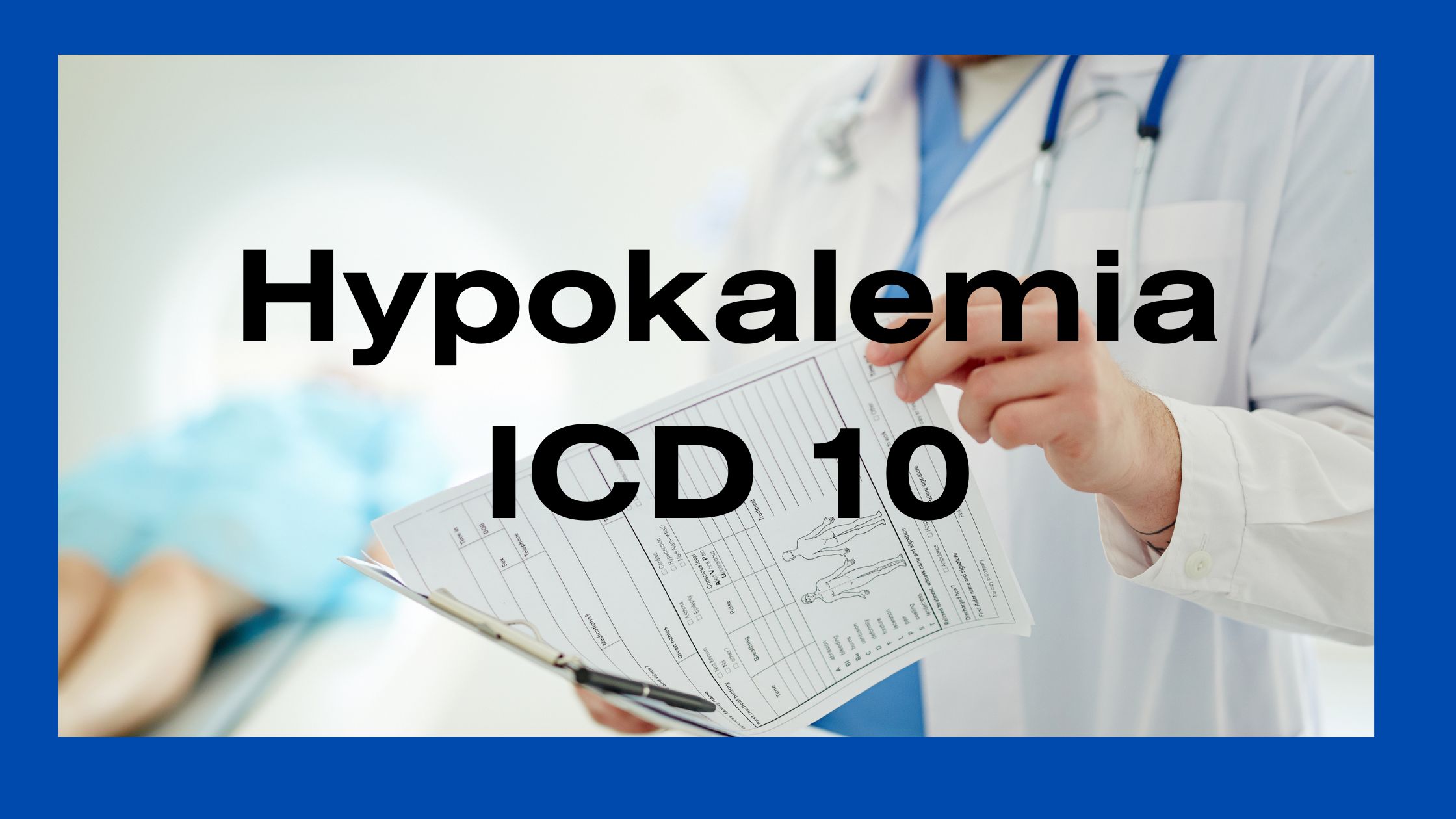Hypokalemia ICD 10 code E87.6, as per refers to a medical condition characterized by low levels of potassium in the bloodstream. In this comprehensive article, we will delve into the causes, symptoms, diagnosis, treatment, and prevention of hypokalemia.
Table of Contents
- Causes of Hypokalemia:
- List of Related Hypokalemia ICD 10 Codes
- Symptoms of Hypokalemia:
- Diagnosis of Hypokalemia:
- Treatment of Hypokalemia:
- Prevention of Hypokalemia:
- FAQ about Hypokalemia
- Related Articles:
Causes of Hypokalemia:
1. Insufficient Dietary Intake: One of the primary reasons for hypokalemia is an inadequate intake of potassium-rich foods. Potassium, an essential mineral, can be found in various fruits, vegetables, whole grains, and legumes. When the diet lacks these sources, it can lead to low potassium levels in the body. To ensure optimal potassium intake, it is recommended to incorporate foods such as bananas, oranges, avocados, tomatoes, spinach, and beans into your diet.
2. Excessive Losses: Certain medical conditions and lifestyle factors can cause excessive potassium loss through urine, sweat, or feces. Chronic kidney disease, excessive alcohol consumption, prolonged vomiting or diarrhea, eating disorders, and the use of certain medications like diuretics can all contribute to hypokalemia. It is important to manage these conditions and make necessary lifestyle changes to prevent potassium depletion.
3. Magnesium Deficiency: Low levels of magnesium in the body can impair potassium absorption and utilization, leading to hypokalemia. Magnesium plays a vital role in maintaining electrolyte balance and proper functioning of cells. Ensure an adequate intake of magnesium-rich foods such as nuts, seeds, whole grains, and leafy green vegetables.
4. Hormonal Disorders: Some hormonal imbalances, such as hyperaldosteronism or Cushing’s syndrome, can disrupt the body’s potassium balance and contribute to hypokalemia. Proper diagnosis and management of these hormonal disorders are crucial in maintaining potassium levels within the normal range.
List of Related Hypokalemia ICD 10 Codes
- E87.6 Hypokalemia: This code signifies a lower-than-normal level of potassium in the blood, which can also have negative effects on the heart and muscle function.
- E87.0 Hyperosmolality and hypernatremia: This code is used to indicate a condition where there is an elevated concentration of osmolytes (substances like electrolytes) and sodium in the blood. This can lead to dehydration and an imbalance in the body’s electrolyte levels.
- E87.1 Hypo-osmolality and hyponatremia: This code signifies a condition characterized by low osmolyte and sodium concentrations in the blood. This can result in an electrolyte imbalance that might lead to symptoms like confusion, headache, and nausea.
- E87.2 Acidosis: This code is a general category for conditions where the blood becomes more acidic due to an excess of acid or a decrease in the body’s ability to remove acid. It includes various specific types of acidosis.
- E87.20 Unspecified: This code is used when the type of acidosis is not specified.
- E87.21 Acute metabolic acidosis: Refers to a sudden increase in blood acidity due to disturbances in metabolism.
- E87.22 Chronic metabolic acidosis: Signifies a long-term increase in blood acidity due to metabolic issues.
- E87.29 Other acidosis: Covers acidosis cases that don’t fit into the acute or chronic metabolic categories.
- E87.3 Alkalosis: This code represents a condition where the blood becomes more alkaline (basic) due to an excess of base or a decrease in acids. Similar to acidosis, it includes various specific types of alkalosis.
- E87.4 Mixed disorder of acid-base balance: This code is used when there’s an abnormal combination of both acidosis and alkalosis occurring simultaneously.
- E87.5 Hyperkalemia: This code indicates an elevated level of potassium in the blood, which can lead to heart rhythm abnormalities and other complications.
- E87.7 Fluid overload: This code is used when there is an excessive accumulation of fluid in the body’s tissues or bloodstream.
- E87.70 Unspecified: Used when the specific cause or nature of fluid overload isn’t specified.
- E87.71 Transfusion associated circulatory overload: Refers to a condition where excessive fluid is administered during a blood transfusion, causing circulatory problems.
- E87.79 Other fluid overload: Includes cases of fluid overload that don’t fit the transfusion-associated category.
- E87.8 Other disorders of electrolyte and fluid balance, not elsewhere classified: This code covers a range of disorders related to electrolyte and fluid balance that aren’t covered by the previous codes.
- E88 Other and unspecified metabolic disorders: This code refers to a category of metabolic disorders not covered by the previous codes.
- E88.0 Disorders of plasma-protein metabolism, not elsewhere classified: This code indicates disorders related to the metabolism of plasma proteins.
- E88.01 Alpha-1-antitrypsin deficiency: Refers to a genetic disorder where the body doesn’t produce enough alpha-1-antitrypsin protein, leading to lung and liver problems.
- E88.02 Plasminogen deficiency: This code represents a rare genetic disorder where the body doesn’t produce enough plasminogen, potentially leading to abnormal bleeding and wound healing.
- E88.09 Other disorders of plasma-protein metabolism, not elsewhere classified: Includes other disorders of plasma protein metabolism that don’t fit the previous categories.
Symptoms of Hypokalemia:
1. Weakness and Fatigue: Low potassium levels can cause muscle weakness and fatigue, making even simple tasks challenging to perform. This can significantly impact an individual’s quality of life.
2. Muscle Cramps: Hypokalemia often manifests as muscle cramps, especially in the legs and arms. These cramps can range from mild discomfort to severe pain, and may be triggered by physical activity or even at rest.
3. Abnormal Heart Rhythm: Potassium is crucial for maintaining proper heart function. Inadequate levels can lead to irregular heartbeats, palpitations, and in severe cases, cardiac arrhythmias. These abnormalities can pose serious health risks and should be addressed promptly.
4. Constipation: Reduced potassium levels can cause digestive issues like constipation, as potassium is involved in smooth muscle contractions in the gastrointestinal system. Adequate hydration and dietary changes can help alleviate this symptom.
5. Increased Urination: Some individuals with hypokalemia may experience increased urination due to impaired kidney function. This can lead to excessive fluid loss and further exacerbate the potassium imbalance.
Diagnosis of Hypokalemia:
If you suspect you may have hypokalemia, it is crucial to consult a healthcare professional for a proper diagnosis. The following diagnostic tests are commonly used:
1. Blood Tests: A simple blood test can measure potassium levels in the bloodstream. Normal potassium levels typically range between 3.5 to 5.0 milliequivalents per liter (mEq/L). Levels below this range indicate hypokalemia. It is important to note that other factors, such as medications and certain medical conditions, can affect potassium levels, so a comprehensive evaluation is necessary.
2. Urine Tests: A 24-hour urine collection may be required to assess the amount of potassium being excreted. This test helps determine if excessive potassium loss is contributing to hypokalemia. It also helps identify any underlying kidney-related issues.
3. ECG (Electrocardiogram): An ECG is often performed to evaluate heart function and detect any abnormalities associated with hypokalemia, such as arrhythmias. This test provides valuable insights into the impact of hypokalemia on cardiac health.
Treatment of Hypokalemia:
Treatment for hypokalemia aims to replenish potassium levels and address the underlying cause. The following interventions may be recommended:
1. Potassium Supplements: Depending on the severity of the condition, your healthcare provider may prescribe oral or intravenous potassium supplements to restore potassium levels in the body. It is essential to follow the prescribed dosage and monitor potassium levels regularly to avoid potential complications.
2. Dietary Modifications: Increasing potassium-rich foods in your diet can help prevent and manage hypokalemia. In addition to the aforementioned fruits and vegetables, other sources of potassium include potatoes, yogurt, milk, fish, and lean meats. A balanced diet that includes these foods can contribute to maintaining optimal potassium levels.
3. Medication Adjustments: If medications are causing potassium loss, your healthcare provider may need to adjust the dosages or switch to alternative options. It is crucial to communicate any concerns or side effects to your healthcare provider to ensure appropriate adjustments are made.
4. Treating Underlying Conditions: Addressing the root cause of hypokalemia, such as managing kidney disease or hormonal imbalances, is crucial for long-term management. Collaborate with your healthcare team to develop an individualized treatment plan that addresses the underlying conditions contributing to hypokalemia.
Prevention of Hypokalemia:
Taking preventive measures can help minimize the risk of developing hypokalemia. Consider the following:
1. Eat a Balanced Diet: Ensure your diet includes a variety of potassium-rich foods to maintain adequate potassium levels. Incorporate fruits, vegetables, whole grains, legumes, and other recommended sources of potassium into your daily meals.
2. Stay Hydrated: Proper hydration helps maintain electrolyte balance, including potassium. Drink an adequate amount of water throughout the day to support overall health and electrolyte regulation.
3. Limit Alcohol Consumption: Excessive alcohol intake can increase the risk of hypokalemia. Alcohol has diuretic effects and can lead to increased potassium excretion. Moderation is key to maintaining optimal potassium levels.
4. Follow Medication Instructions: If you are prescribed diuretics or other medications that can lead to potassium loss, ensure you take them as directed and discuss any concerns with your healthcare provider. They can provide guidance on managing medication-related potassium imbalances.
In conclusion, hypokalemia is a condition characterized by low levels of potassium in the bloodstream. Understanding the causes, symptoms, diagnosis, treatment, and prevention of this condition is essential for maintaining good health. If you suspect you may have hypokalemia, consult with a healthcare professional for proper evaluation and guidance. By addressing the underlying causes, managing symptoms, and making necessary lifestyle changes, individuals can effectively manage and prevent hypokalemia.
FAQ about Hypokalemia
Ans. Hypokalemia can be caused by insufficient dietary intake of potassium-rich foods, excessive losses through urine, sweat, or feces, magnesium deficiency, and hormonal disorders.
Ans. Symptoms of hypokalemia include weakness and fatigue, muscle cramps, abnormal heart rhythm, constipation, and increased urination.
Ans. Hypokalemia is diagnosed through blood tests to measure potassium levels, urine tests to assess potassium excretion, and an electrocardiogram (ECG) to evaluate heart function.
Ans. Treatment for hypokalemia may include potassium supplements, dietary modifications, medication adjustments, and treating underlying conditions such as kidney disease or hormonal imbalances.


